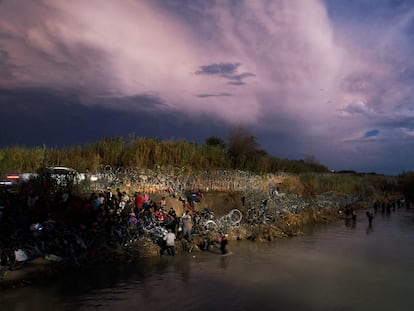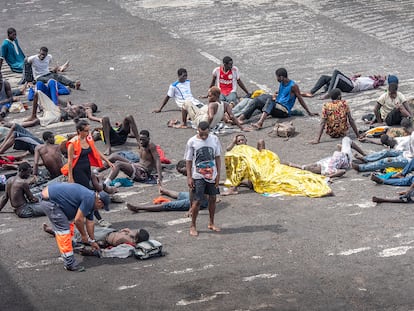Hope on the US-Mexico border: ‘People get through every day. Today I’m going in with God’s blessing’
In Ciudad Juárez, hundreds of migrants, especially Venezuelans, are waiting to cross and surrender to the border police, encouraged by many others who have already done it. Their fate: a legal limbo awaiting deportation trials
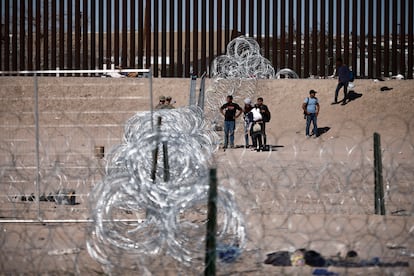

The most difficult part is not to cut yourself when you’re crossing the fence. You should put a thick blanket or a bundle of clothing over the blades before jumping. Or, if you’re lucky, someone will have some pliers to cut a hole and then you can crawl through. Once inside, put your hands up in the air, walk slowly along the wall, and surrender to the border patrol at Gate 36.
This is the instruction manual of Alejandro Cárdenas, a recent graduate in architecture from the University of Caracas in Venezuela. His cousin, who crossed into the U.S. last week, has explained everything step by step on WhatsApp. Now the rest of the Cárdenas family is hoping to follow suit: three other cousins, two sisters, the mother and a three-year-old granddaughter. They are all waiting on the Mexican edge of the Rio Grande, which at this particular point is just a stream 13 feet across from bank to bank, convinced that tonight they are going to make it: “People get through every day. Today I am going in with God’s blessing.”
Gate 36 on the border between Ciudad Juárez (Chihuahua) and El Paso (Texas) has become a kind of lucky charm for hundreds of migrants, especially Venezuelans, who in recent weeks have been focusing their efforts on this piece of desert land, loaded with faith. There are remains of clothing on the ground, and even a tent. They even set up small camps at the very first American crossing, past the river, at arm’s length of the wire fences. In recent days, videos of large groups of people racing ahead amid the resigned look of Mexican immigration officers have spread on social media.
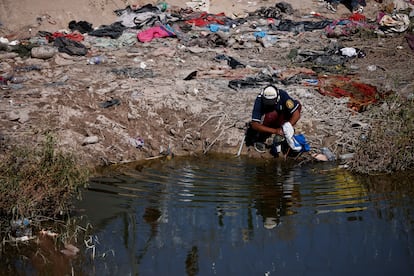
So much commotion has caused a reinforcement of security in the area. The Texas National Guard has been dismantling the camps and tonight there are five vans guarding them and a handful of armed guards. From time to time, a blue police siren light shines in the face of someone in the group, but it doesn’t seem to be enough to intimidate them. “I’ve been traveling on foot for two months, I’ve seen people die, I’ve been robbed, I’ve been hungry, so now I’m not going to leave here,” says Gregorio Vázquez, owner of a small mechanical workshop in a Venezuelan town. While he explains how his wife and daughter recently crawled through one of the holes in the wire fence, a voice says that another group has managed to get to the other side and is going through the famous Gate 36. They scream, dance and clench their fists. It is an injection of adrenaline for the people who continue to arrive at this spot, oblivious to the wind that blows ever bigger puffs of sand in their faces. “Papi, we’re going to be next,” says a woman with her face covered with a scarf to protect herself from the dust.
Border patrol records estimate that in September alone, 50,000 Venezuelans entered the United States without papers. They are one of the nationalities that is contributing most to the migrant surge that has been growing since May, coinciding with the expiration of Title 42, an exceptional measure adopted during the Covid pandemic that allowed immediate deportation without any procedure. Analysts explain the reasons for this peak in Venezuelans as cause-effect stemming from a mixture of good news and half-baked rumors.
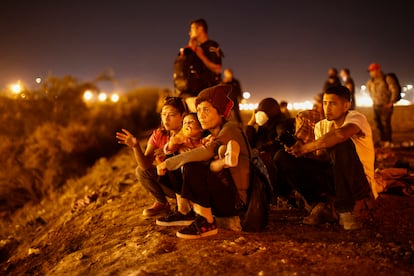
On the one hand, it is true that the U.S. government has granted work permits through quotas for Venezuelans. It is also true that since there is no bilateral deportation treaty after the diplomatic rupture since the days of Hugo Chávez, when Venezuelans are detained at the border they usually go into a legal limbo until the day of their trial. This hiatus can last up to two years. But that doesn’t mean everyone is welcome. The Department of Homeland Security has already announced this week that it has reached an agreement with Caracas. Deportations will begin “rapidly in the coming days.”
Rocky Balboa in El Paso
Karismar Rodríguez is 38 years old and has just been released from one of the tent-like migrant detention centers in El Paso. She crossed the river five days ago, put a blanket over the blades and surrendered to the police. On Thursday afternoon, a few hours before her compatriots prepared to cross at night, she sat on a street in the Texas city and explained how bad she had it until they released her. “They woke us up at 4 a.m. to take a shower and they barely gave me any medicine.” Karismar’s eyes are very red and she keeps blinking while she talks. The last stage to reach the border involved three days on the roof of a train, the nefarious Beast as it is known among migrants. “Because of so much wind and so much cold I got ear infections. And now I think I have an eye infection.”
Her husband, who accompanied her during the two-month journey across nearly 10 countries, listens to her and nods his head. He remembers seeing corpses floating in the Darién, the jungle that separates Colombia from Panama. But he is adamant that the worst part was in Mexico. “The police pulled us off the train, stole our money and left us stranded in the desert. And thank goodness we got rid of the bad guys (coyotes, or human traffickers).” He summarizes their odyssey like this: “We are like Rocky Balboa, the boxer in the movie, carrying a pain all day long.”
They both have a yellow bracelet on their wrist. It means that they are going to be sent from Texas to some of the “sanctuary” cities, so called because of their more welcoming policy towards migrants. They are going to New York, where they have their first hearing pending a deportation trial in June 2024. They will not be able to work legally and will have to struggle to get by. “I don’t know what will happen, but I’m sure I’ll be better off there than in my country.”

The family next to them is being sent to Chicago. They are also Venezuelans. The mother says that they also crossed in several groups. One of her children, almost a baby, is playing on the sidewalk. The street is crowded. The city has even placed public toilets on the sidewalks. Everyone waits at the door of a church that is painted blue and has a giant effigy of Our Lady of Guadalupe to be given food and some clothes. El Paso, a Democratic oasis within very Republican Texas, is saturated. There is no more room in the shelters. Mayor Oscar Leeser declared in late September that the city had reached a “breaking point” and could no longer help all migrants.
The mayor has even expressed gratitude for the policy of the Texas governor, Greg Abbott, a tough Republican hawk who is distributing new arrivals throughout America’s so-called sanctuary cities. It is a pressure strategy to erode the most permissive measures of President Biden’s administration with regard to migration. Abbot is addicted to provocation. He has created a wall of buoys in the widest parts of the river and routinely blocks commercial entry points by land with the excuse of conducting comprehensive controls, creating million-dollar economic losses for Mexico.
Faced with pressure, Biden has progressively tightened his policy at the border. In May, after the end of Title 42, he sent more than 24,000 agents to patrol the nearly 2,000-mile strip. In late September he sent 800 more and announced an acceleration in deportations. And this week, the president did a U-turn on his pledge when he took office: “No more American taxes will be used to build a wall.” Through a decree, he has waived 26 federal laws, which will allow the construction of 20 miles (32 kilometers) of barriers in South Texas.
The massive arrival of migrants in recent months could well break all recent records. The forecast is more than 200,000 arrests in 2023. From now on, the government will combine a heavy hand with measures to regulate migratory flows, such as quotas, bilateral agreements with countries of origin and the digital system to request asylum through the CBP One application. On the streets of El Paso, a veteran Venezuelan believes that his compatriots will continue to come regardless. He has a tattoo above his right eyebrow that says “The Neck,” his nickname since he was a bus driver in a Caracas neighborhood. “Over there, money won’t buy you anything.” He has been in El Paso for almost a year. He has already been to his second deportation hearing but still does not have a final date. The Neck says goodbye and rides off on a red bicycle because tomorrow he has to get up early to work at a construction site “for some good dollars.”
Sign up for our weekly newsletter to get more English-language news coverage from EL PAÍS USA Edition
Tu suscripción se está usando en otro dispositivo
¿Quieres añadir otro usuario a tu suscripción?
Si continúas leyendo en este dispositivo, no se podrá leer en el otro.
FlechaTu suscripción se está usando en otro dispositivo y solo puedes acceder a EL PAÍS desde un dispositivo a la vez.
Si quieres compartir tu cuenta, cambia tu suscripción a la modalidad Premium, así podrás añadir otro usuario. Cada uno accederá con su propia cuenta de email, lo que os permitirá personalizar vuestra experiencia en EL PAÍS.
¿Tienes una suscripción de empresa? Accede aquí para contratar más cuentas.
En el caso de no saber quién está usando tu cuenta, te recomendamos cambiar tu contraseña aquí.
Si decides continuar compartiendo tu cuenta, este mensaje se mostrará en tu dispositivo y en el de la otra persona que está usando tu cuenta de forma indefinida, afectando a tu experiencia de lectura. Puedes consultar aquí los términos y condiciones de la suscripción digital.
More information
Archived In
Últimas noticias
Most viewed
- Sinaloa Cartel war is taking its toll on Los Chapitos
- Reinhard Genzel, Nobel laureate in physics: ‘One-minute videos will never give you the truth’
- Oona Chaplin: ‘I told James Cameron that I was living in a treehouse and starting a permaculture project with a friend’
- Why the price of coffee has skyrocketed: from Brazilian plantations to specialty coffee houses
- David King, chemist: ‘There are scientists studying how to cool the planet; nobody should stop these experiments from happening’
